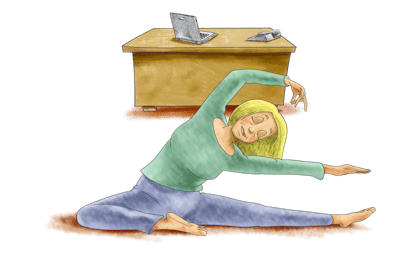For some, hearing the word mindfulness may well conjure up an image of a person sitting on the floor in the lotus position, ‘om’ing profusely.
Whilst in some cases this is certainly valid, there are so many different avenues to take toward being a more mindful individual.
I’d love to share two simple things that I try to do on a daily basis, that helped me realise the benefits of mindfulness myself.
1. Create a morning ritual
This I find to be the most beneficial aspect of the whole process.
Why?
Because it sets you up for the day in the most positive way possible.
The following scenario may seem startlingly familiar:
Alarm goes off. You pry open your weary eyes and reach over to your bedside (or even under your pillow) to end its victory shriek. Then what do you do? I’ll bet there’s a few notifications to check. And maybe a few emails. Photos. Updates. Next thing you know you’ve been scrolling mindlessly for way longer than you expected, you might even skip breakfast (again) and turn up to work already stressed out.
It really is hard to break out of these sorts of habits, so difficult for myself that I’ve actually resorted to charging my phone in the kitchen and using a good old analog clock for my morning alarm. But it works.
Now, a few better ways that 15 minutes of scrolling time can be spent:
- Go outside, first thing — it’s as simple as going onto the balcony, into the garden or even opening up the window. Allow your senses to fully take the natural world in, then move on to starting the day.
- Have a stretch — you’re likely going to spend a lot of the day sitting down, so your joints and muscles will love you for giving them some pre-emptive TLC. Mindfully paying attention to your body, it’s aches and pains, and feeling the strength in your movements will help you build your sense of personal awareness. Not to mention, stretching is used clinically to treat anxiety, insomnia, tension headaches and other stress-related disorders.
- Write down 5 things you’re grateful for — no matter how insignificant they may seem. Allowing yourself to recognise some positives before you’ve had any exposure to the outside world is helpful in improving your mindset. If you can’t think of five straight away, keep that list and add to it throughout the day.
2. Meditate
Although the morning is a great time to start practicing, it can be performed at any time that suits you. Whatever time you choose, a 10-minute life hiatus in the form of meditation is seriously powerful. Below I’ll walk (sit) through a specifically mindfulness-based meditation that’s focused on breathing.
- Find a comfortable place to sit. This can be in a chair, on the floor, wherever you feel you’ll be most relaxed. Although, try to steer clear of laying down as this may prompt you to doze off. Set yourself a timer so you don’t have to worry about when to stop.
- Notice the points where your body is touching the floor or the chair. How does it feel? Is your body feeling heavy or light, even or uneven? Take a few moments to release any tension in your muscles. Drop your shoulders, lower your chin slightly and let your spine fall in its natural position.
- Take a few exaggerated breaths. In for 3 seconds, hold it for 2, then out for 4.
- Next, either gently close your eyes or just let your gaze sit wherever it falls.
- From here, simply notice your breath as it occurs naturally. Don’t try to force or change it. Notice where the breath begins through the nose, how it travels through the lungs and into the abdomen, and how it lightly fades away.
- When your mind starts to wander (and it will, maybe even after just a few breaths) notice where exactly it wants to go. Is it a distressing event, a task you’ve been putting off, troubles with your relationships? It could be as menial as what you’re going to have for lunch. Don’t be frustrated about having these thoughts, it certainly doesn’t mean you’re not meditating ‘properly’. You are giving yourself the chance to notice, accept and move on from your negative thoughts. This is what it’s all about.
- Now comes the part where we allow the thoughts to exist wherever they may, and train the mind to return to the present. Some people like to internally repeat a word like ’thinking’ or ‘attention’ to give the wandering brain some encouragement.
If this sounds like too much to start off with, you don’t have to try and do it all. The most relieving part is that you don’t even have to take a whole ten minutes.
You could spend five, or even just one minute to have a breath and centre yourself whenever you feel necessary. At your desk, in the car on the way to work (maybe stick to keeping the eyes open with that one), or in the kitchen as you make dinner.
It really is as simple as taking these purposeful pauses here and there to redirect your attention and recharge your brain.
The most important point to clarify is that there is no set structure, rule or method that you must follow, as mindfulness is inherently subjective. Like any exercise, the main takeaway is consistency — and with enough healthy persistence and determination, it’s a valuable resource that you will be able to sustain in every aspect of your life.
Now if you’re after some bonus reading, here are a few more great resources:
How to practice mindfulness | Pocket Mindfulness
Meditation - start here | mindful.org
Mindfulness - how to do it | mindful.org
Simpler guide to minfulness | mindful.org
Five steps to mindfulness | mindful.org

